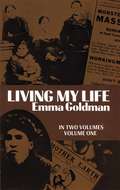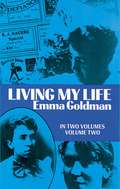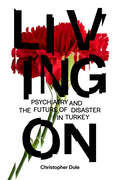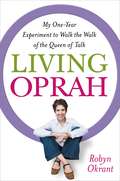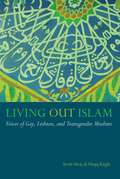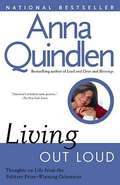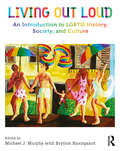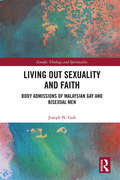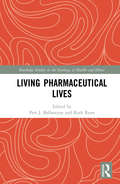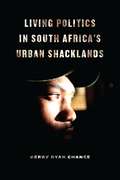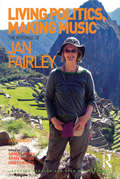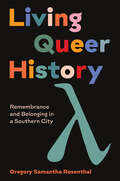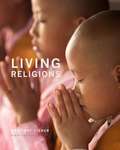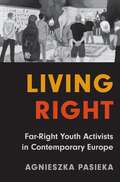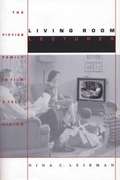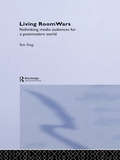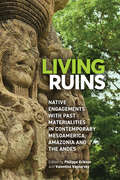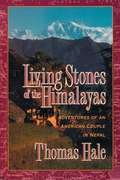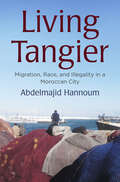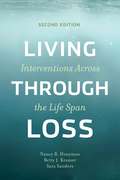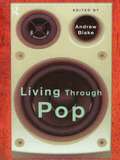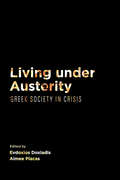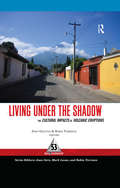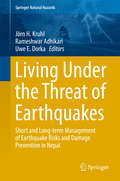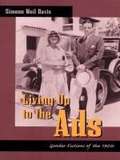- Table View
- List View
Living My Life, Vol. 1
by Emma Goldman“You damn bitch of an anarchist, I wish I could get at you. I would tear your heart out and feed it to my dog.” This was one of the less obscene messages received by Emma Goldman (1869-1940), while in jail on suspicion of complicity in the assassination of McKinley. The most notorious woman of her day, she was bitterly hated by millions and equally revered by millions.The strong feelings she aroused are understandable. She was an alien, a practicing anarchist, a labor agitator, a pacifist in World War 1, an advocate of political violence, a feminist, a proponent of free love and birth control, a communist, a street-fighter for justice — all of which she did with strong intellect and boundless passion. Today, of course, many of the issues that she fought over are just as vital as they were then.Emma Goldman came from Russia at the age of 17. After an encounter with the sweatshop and an unfortunate marriage, she plunged into the bewildering intellectual and activist chaos that attended American social evolution around the turn of the twentieth century. She knew practically everyone of importance in radical circles. She dominated many areas of the radical movement, lecturing, writing, haranguing, and publishing to awaken the world to her ideas. After World War I she was deported to Russia, where she soon discovered that anarchists were no better liked than in America, despite Lenin’s first gesture of welcome. She escaped with her life but never was allowed to return to the United States.Emma Goldman was a devastatingly honest woman, who spared herself as little as she spared anyone else. From her account the reader can gain insight into a curious personality type of recurrent interest: a woman who devoted her life to eliminating suffering, yet could make a bomb or assist in staging an assassination. Equally interesting are her comments on other radicals of the period, such as Kropotkin, Berkman, Mooney, Lenin, Trotsky, Haywood, Most, the Haymarket martyrs, and many others. Her autobiography, written with vigor, ranks among the finest in the English language.
Living My Life, Vol. 1
by Emma GoldmanThe no-holds-barred account by American anarchist Goldman relates her philosophical and political journey through life. Explore the politicization of the young Russian immigrant as she arrives in the United States in 1886, and how she wends her way through the labyrinth of American, Russian, and European politics over the next 40 years.
Living On: Psychiatry and the Future of Disaster in Turkey
by Christopher T. DoleLiving On centers around the unprecedented mobilization of mental health professionals in the wake of a massive earthquake that struck western Turkey in 1999—a disaster that left more than 20,000 people dead and hundreds of thousands of residents displaced. Working amid unimaginable destruction and suffering, volunteer psychiatrists and psychologists would quickly improvise a makeshift response, offering thousands of survivors access to psychiatric care for the first time. Never before had there been such a collective expression of concern for people's psychological well-being. Christopher Dole explores how this psychiatric response fashioned individual and collective lives far into the disaster's future. Based on research spanning two decades, from the earthquake to its twentieth anniversary, he considers how this convergence of geological activity and psychiatric expertise introduced novel psychiatric and psychological discourses into everyday lives of survivors, as it also animated new visions of self, society, and technopolitical promise. Living On not only offers insight into Turkey's transformations over the opening decades of the twenty-first century, but it also sheds light on a more general arrangement of disaster, governance, and medical expertise—one that increasingly characterizes our era of planetary ecological crisis.
Living Oprah: One Woman, One Year, All Oprah
by Robyn OkrantWhat happens when a thirty-five-year-old average American woman spends one year following every piece of Oprah Winfrey's advice on how to "live your best life"? Robyn Okrant devoted 2008 to adhering to all of Oprah's suggestions and guidance delivered via her television show, her Web site, and her magazine. LIVING OPRAH is a month-by-month account of that year. Some of the challenges included enrollment in Oprah's Best Life Challenge for physical fitness and weight control, living vegan, and participating in Oprah's Book Club. After 365 days of LIVING OPRAH, Okrant reflects on the rewards won and lessons learned as well as the tolls exacted by the experiment.
Living Out Islam: Voices of Gay, Lesbian, and Transgender Muslims
by Scott Siraj Kugle2015 Israel Fishman Non-Fiction Award presented by the Stonewall Books Awards of the American Library AssociationMuhsin is one of the organizers of Al-Fitra Foundation, a South African support group for lesbian, transgender, and gay Muslims. Islam and homosexuality are seen by many as deeply incompatible. This, according to Muhsin, is why he had to act. “I realized that I’m not alone—these people are going through the very same things that I’m going through. But I’ve managed, because of my in-depth relationship with God, to reconcile the two. I was completely comfortable saying to the world that I’m gay and I’m Muslim. I wanted to help other people to get there. So that’s how I became an activist.”Living Out Islam documents the rarely-heard voices of Muslims who live in secular democratic countries and who are gay, lesbian, and transgender. It weaves original interviews with Muslim activists into a compelling composite picture which showcases the importance of the solidarity of support groups in the effort to change social relationships and achieve justice. This nascent movement is not about being “out” as opposed to being “in the closet.” Rather, as the voices of these activists demonstrate, it is about finding ways to live out Islam with dignity and integrity, reconciling their sexuality and gender with their faith and reclaiming Islam as their own.
Living Out Loud
by Anna Quindlen"A panopticon of life in this decade, sure to be valuable to future social historians She touches on life, love, home, family, work, men, women, children and issues large and small."CHICAGO TRIBUNEThe voice is Anna Quindlen's. But we know the hopes, dreams, fears, and wonder expressed in all her columns, for most of us share them. With her NEW YORK TIMES-based column, "LIFE IN THE 30s," Anna Quindlen valued to national attention, and this wonderful collection shows why.As she proved in OBJECT LESSONS and THINKIN OUT LOUD, Anna Quindlen's views always fascinate.From the Trade Paperback edition.
Living Out Loud: An Introduction to LGBTQ History, Society, and Culture
by Michael J. Murphy Brytton BjorngaardLiving Out Loud: An Introduction to LGBTQ History, Society, and Culture offers students an evidence-based foundation in the interdisciplinary field of LGBTQ Studies. Chapters on history, diversity, dating/relationships, education, sexual health, and globalization reflect current research and thinking in the social sciences, humanities, and sciences. Coverage of current events and recommendations for additional readings, videos, and web resources help students apply the contents in their lives, making Living Out Loud the perfect core text for LGBTQ+ Studies (and similar) courses.
Living Out Sexuality and Faith: Body Admissions of Malaysian Gay and Bisexual Men (Gender, Theology and Spirituality)
by Joseph N. GohSexuality, religion and faith often have complex and conflicting interactions, on both personal and societal levels. Numerous studies have been conducted on queer subjects, but they have predominantly focused on ‘Western’ expressions of faith and queer identities. This book contributes to the wider scholarship on queer subjects by drawing on actual lived experiences of self-identifying gay and bisexual men in Malaysia. It discusses what we can learn from the realities of their lives that intersect with their religious, spiritual, theological or humanistic values in an Asian context. Analysed within the critical frameworks of queer theory and queer sexual theology, this study divulges the meanings ascribed to sexual identities and practices, as well as conceptualisations of masculinity, sexual desire, love and intimate physical connections. It also lays bare the complex negotiations between gender, desire and spirit, and how they can affect one another. Tying fascinating case studies and underexplored Asian theologies with wider conversations around sexuality and faith, this book will be of significant interest to scholars working in religious studies, theology, queer studies, sexuality studies and Asian studies.
Living Pharmaceutical Lives
by Kath Ryan Peri J. BallantyneIncreasingly, pharmaceuticals are available as the solutions to a wide range of human health problems and health risks, minor and major. This book portrays how pharmaceutical use is, at once, a solution to, and a difficulty for, everyday life. Exploring lived experiences of people at different stages of the life course and from different countries around the world, this collection highlights the benefits as well as the challenges of using medicines on an everyday basis. It raises questions about the expectations associated with the use of medications, the uncertainty about a condition or about the duration of a medicine regimen for it, the need to negotiate the stigma associated with a condition or a type of medicine, the need to access and pay for medicines and the need to schedule medicine use appropriately, and the need to manage medicines’ effects and side effects. The chapters include original empirical research, literature review and theoretical analysis, and convey the sociological and phenomenological complexity of ‘living pharmaceutical lives’. This book is of interest to all those studying and researching social pharmacy and the sociology of health and illness.
Living Politics in South Africa’s Urban Shacklands
by Kerry Ryan ChanceWhile much has been written on post-apartheid social movements in South Africa, most discussion centers on ideal forms of movements, disregarding the reality and agency of the activists themselves. In Living Politics, Kerry Ryan Chance radically flips the conversation by focusing on the actual language and humanity of post-apartheid activists rather than the external, idealistic commentary of old. Tracking everyday practices and interactions between poor residents and state agents in South Africa’s shack settlements, Chance investigates the rise of nationwide protests since the late 1990s. Based on ethnography in Durban, Cape Town, and Johannesburg, the book analyzes the criminalization of popular forms of politics that were foundational to South Africa’s celebrated democratic transition. Chance argues that we can best grasp the increasingly murky line between “the criminal” and “the political” with a “politics of living” that casts slum and state in opposition to one another. Living Politics shows us how legitimate domains of politics are redefined, how state sovereignty is forcibly enacted, and how the production of new citizen identities crystallize at the intersections of race, gender, and class.
Living Politics, Making Music: The Writings of Jan Fairley (Ashgate Popular and Folk Music Series)
by Ian Christie Jan Fairley edited by FrithThe late Jan Fairley (1949-2012) was a key figure in making world music a significant topic for popular music studies and an influential contributor to such world music magazines as fRoots and Songlines. This book celebrates her contribution to popular music scholarship by gathering her most important work together in a single place. The result is a richly informed and entertaining volume that will be of interest to all scholars in the field while also serving as an excellent introduction for students interested in popular music as a global phenomenon. Fairley’s work was focused on the problems and possibilities of cross-cultural musical influences, fantasies and flows and on the importance of performing circuits and networks. Her interest in the details of music-making and in the lives of music-makers means that this collection is also an original and illuminating study of music and politics. In drawing on Jan Fairley’s journalism, this volume also offers students a guide to various genres of world music, from Cuban son to flamenco, as well as an insight into the lives of such world music stars as Mercedes Sosa and Silvio RodrÃguez. This is inspiring as well as essential reading.
Living Queer History: Remembrance and Belonging in a Southern City
by Gregory Samantha RosenthalQueer history is a living practice. Talk to any group of LGBTQ people today, and they will not agree on what story should be told. Many people desire to celebrate the past by erecting plaques and painting rainbow crosswalks, but queer and trans people in the twenty-first century need more than just symbols—they need access to power, justice for marginalized people, spaces of belonging. Approaching the past through a lens of queer and trans survival and world-building transforms history itself into a tool for imagining and realizing a better future. Living Queer History tells the story of an LGBTQ community in Roanoke, Virginia, a small city on the edge of Appalachia. Interweaving &8239;historical analysis, theory, and memoir, Gregory Samantha Rosenthal tells the story of their own journey—coming out and transitioning as a transgender woman—in the midst of working on a community-based history project that documented a multigenerational southern LGBTQ community. Based on over forty interviews with LGBTQ elders, Living Queer History explores how queer people today think about the past and how history lives on in the present.
Living Religions
by Mary FisherLiving Religions emphasizes the personal consciousness of believers and their own accounts of their religion and relevance in the present day. Mary Pat Fisher considers how the contemporary beliefs and practices of each of these traditions has evolved, and explores the changing nature of each religion. The ninth edition focuses on cultural customs, popular spiritual practices, mixtures of religions, and varieties of religions ways. Expanded coverage of women, including women's voices and contributions, is woven into the discussion of each religion. Living Religions provides a sympathetic approach to the historical teachings of traditional faiths, indigenous religions, and new religious movements. The text follows a clear and straightforward account of the development, doctrines, and practices of the major faiths followed today.
Living Right: Far-Right Youth Activists in Contemporary Europe
by Agnieszka PasiekaA sobering look at the seductive power of fascist ideas for the youngRadical nationalism is on the rise in Europe and throughout the world. Living Right provides an in-depth account of the ideas and practices that are driving the varied forms of far-right activism by young people from all walks of life, revealing how these social movements offer the promise of comradery, purpose, and a moral calling to self-sacrifice, and demonstrating how far-right ideas are understood and lived in ways that speak to a variety of experiences.In this eye-opening book, Agnieszka Pasieka draws on her own sometimes harrowing fieldwork among Italian, Polish, and Hungarian militant youths, painting unforgettable portraits of students, laborers, entrepreneurs, musicians, and activists from well-off middle class backgrounds who have all found a nurturing home in the far right. Providing an in-depth account of radical nationalist communities and networks that are taking root across Europe, she shows how the simultaneous orientation of these groups toward the local and the transnational is a key to their success. With a focus on far-right morality that challenges commonly held ideas about the right, Pasieka describes how far-right movements afford opportunities to the young to be active members of tightly bonded comradeships while sharing in a broader project with global ramifications.Required reading for anthropologists and anyone concerned about the resurgence of far-right militancy today, Living Right sheds necessary light on the forces that have made the growing appeal of fascist idealism for young people one of the most alarming trends of our time.
Living Room Lectures
by Nina C. LeibmanWith a breadwinner dad, a homemaker mom, and squeaky-clean kids, the 1950s television family has achieved near mythological status as a model of what real families "ought" to be. Yet feature films of the period often portrayed families in trouble, with parents and children in conflict over appropriate values and behaviors. Why were these representations of family apparently so far apart? Nina Leibman analyzes many feature films and dozens of TV situation comedy episodes from 1954 to 1963 to find surprising commonalities in their representations of the family. Redefining the comedy as a family melodrama, she compares film and television depictions of familial power, gender roles, and economic attitudes. Leibman's explorations reveal how themes of guilt, deceit, manipulation, anxiety, and disfunctionality that obviously characterize such movies as Rebel without a Cause, A Summer Place, and Splendor in the Grass also crop up in such TV shows as The Adventures of Ozzie and Harriet, Father Knows Best, Leave It to Beaver, The Donna Reed Show, and My Three Sons. Drawing on interviews with many of the participants of these productions, archival documents, and trade journals, Leibman sets her discussion within a larger institutional history of 1950s film and television. Her discussions shed new light not only on the reasons for both media's near obsession with family life but also on changes in American society as it reconfigured itself in the postwar era.
Living Room Wars: Rethinking Media Audiences
by Ien AngLiving Room Wars brings together Ien Ang's recent writings on television audiences, and , in response to recent criticisms of cultural studies, argues that it is possible to study audience pleasures and popular television in a way that is not naively populist. Ang examines how the makers and marketers of television attempt to mould their audience and looks at the often unexpected ways in which the viewers actively engage with the programmes they watch. Living Room Wars highlights the inherent contradictions of a `politics of pleasure' of television consumption: Ang moves beyond the trditional forcus on textual meanings to explore the structural and historical representations fo television audiences as an integral part of modern culture. Her wide-ranging and illuminating discussion takes in the battle between television and its audiences; the politics of empirical audience research; new technologies and the tactics of television consumption; ethnography and radical contextualism in audience studies; television fiction and women's fantasy; feminist desire and female pleasure in media consumption, and the transnational media system.
Living Ruins: Native Engagements with Past Materialities in Contemporary Mesoamerica, Amazonia, and the Andes
by Philippe Erikson Valentina VapnarskyRuins and remnants of the past are endowed with life, rather than mere relics handed down from previous generations. Living Ruins explores some of the ways Indigenous people relate to the material remains of human activity and provides an informed and critical stance that nuances and contests institutionalized patrimonialization discourse on vestiges of the past in present landscapes. Ten case studies from the Maya region, Amazonia, and the Andes detail and contextualize narratives, rituals, and a range of practices and attitudes toward different kinds of vestiges. The chapters engage with recently debated issues such as regimes of historicity and knowledge, cultural landscapes, conceptions of personhood and ancestrality, artifacts, and materiality. They focus on Indigenous perspectives rather than mainstream narratives such as those mediated by UNESCO, Hollywood, travel agents, and sometimes even academics. The contributions provide critical analyses alongside a multifaceted account of how people relate to the place/time nexus, expanding our understanding of different ontological conceptualizations of the past and their significance in the present. Living Ruins adds to the lively body of work on the invention of tradition, Indigenous claims on their lands and history, “retrospective ethnogenesis,” and neo-Indianism in a world where tourism, NGOs, and Western essentialism are changing Indigenous attitudes and representations. This book is significant to anyone interested in cultural heritage studies, Amerindian spirituality, and Indigenous engagement with archaeological sites in Latin America. Contributors: Cedric Becquey, Laurence Charlier Zeineddine, Marie Chosson, Pablo Cruz, Philippe Erikson, Antoinette Molinié, Fernando Santos-Granero, Emilie Stoll, Valentina Vapnarsky, Pirjo Kristiina Virtanen
Living Stones of the Himalayas: Adventures of an American Couple in Nepal
by Thomas HaleSince 1970, the team of Thomas Hale and his wife, Cynthia, have struggled to serve God as medical doctors in the remote storybook kingdom of Nepal. In the process they have experienced both the hardships and the blessings of bringing Western medicine to people who distrust -- even fear -- ideas differing from their own. n the same process, by their selfless love and caring, they have gained the affection and trust of their Nepali patients and neighbors. In this true story, the faith and humility of doctors Tom and Cynthia Hale are matched by the beguiling personality and character of the Nepalese people, the majority of whom are subsistence farmers who share much in common with the poor of all developing countries. Living Stones of the Himalayas, like its predecessors Don't Let the Goats Eat the Loquat Trees and On the Far Side of Liglig Mountain, is a graphic portrait of the human condition and the growing pains of the unique and intriguing land of Nepal with its astonishing beauty that exists side by side with: - faith and superstition - sickness and death - ancient traditions and twentieth-century innovations - courage and joie de vivre Living Stones of the Himalayas is a fascinating account of everyday and sometimes incredible experiences mingled with humor, understanding, and love for humanity. Reading it will transport you to one of the most enchanting lands away -- first class.
Living Tangier: Migration, Race, and Illegality in a Moroccan City (Contemporary Ethnography)
by Abdelmajid HannoumSince the early 1990s, new migratory patterns have been emerging in the southern Mediterranean. Here, a large number of West Africans and young Moroccans, including minors, make daily attempts to cross to Europe. The Moroccan city of Tangier, because of its proximity to Spain, is one of the main gateways for this migratory movement. It has also become a magnet for middle- and working-class Europeans seeking a more comfortable life.Based on extensive fieldwork, Living Tangier examines the dynamics of transnational migration in a major city of the Global South and studies African "illegal" migration to Europe and European "legal" migration to Morocco, looking at the itineraries of Europeans, West Africans, and Moroccan children and youth, their strategies for crossing, their motivations, their dreams, their hopes, and their everyday experiences. In the process, Abdelmajid Hannoum examines how Moroccan society has been affected by the flows of migrants from both West Africa and Europe, focusing on race relations and analyzing issues related to citizenship and social inequality. Living Tangier considers what makes the city one of the most attractive for migrants preparing to cross to Europe and illustrates not only how migrants live in the city but also how they live the city—how they experience it, encounter its people, and engage its culture, walk its streets, and participate in its events.Reflecting on his own experiences and drawing on the work of Hannah Arendt, Edward Said, Tayeb Saleh, Amin Maalouf, and Dany Laferrière, Hannoum provokes new questions in order to reconfigure migration as a postcolonial phenomenon and interrogate how Moroccan society responds to new cultural processes.
Living Through Loss: Interventions Across the Life Span
by Nancy Hooyman Sara Sanders Betty KramerLiving Through Loss provides a foundational identification of the many ways in which people experience loss over the life course, from childhood to old age. It examines the interventions most effective at each phase of life, combining theory, sound clinical practice, and empirical research with insights emerging from powerful accounts of personal experience.The authors emphasize that loss and grief are universal yet highly individualized. Loss comes in many forms and can include not only a loved one’s death but also divorce, adoption, living with chronic illness, caregiving, retirement and relocation, or being abused, assaulted, or otherwise traumatized. They approach the topic from the perspective of the resilience model, which acknowledges people’s capacity to find meaning in their losses and integrate grief into their lives. The book explores the varying roles of age, race, culture, sexual orientation, gender, and spirituality in responses to loss. Presenting a variety of models, approaches, and resources, Living Through Loss offers invaluable lessons that can be applied in any practice setting by a wide range of human service and health care professionals.This second edition features new and expanded content on diversity and trauma, including discussions of gun violence, police brutality, suicide, and an added focus on systemic racism.
Living Through Pop
by Andrew BlakeIn 1956 many people thought rock `n' roll was a passing fad, yet over forty years later , more than ever, Popular Music is a part of contemporary culture, reinventing itself for successive generations. Pop embraces its own history, with musicians from every genre routinely sampling the sounds of the past. present. Living Through Pop explores popular music's history, and the ways in which it has been produced by musicians, broadcasters, critics and fans. In discussing this complex relationship between the past and the present, the contributors investigate signficant moments in music's history, from the Rolling Stones and the Velvet Underground to the Sex Pistols and the Verve, from drum `n' bass to European extreme techno.
Living Under Austerity: Greek Society in Crisis
by Evdoxios Doxiadis Aimee PlacasSince its sovereign debt crisis in 2009, Greece has been living under austerity, with no apparent end in sight. This volume explores the effects of policies pursued by the Greek state since then (under the direction of the Troika), and how Greek society has responded. In addition to charting the actual effects of the Greek crisis on politics, health care, education, media, and other areas, the book both examines and challenges the “crisis” era as the context for changing attitudes and developments within Greek society.
Living Under the Shadow: Cultural Impacts of Volcanic Eruptions (One World Archaeology Ser. #53)
by Robin Torrence John GrattanPopularist treatments of ancient disasters like volcanic eruptions have grossly overstated their capacity for death, destruction, and societal collapse. Contributors to this volume—from anthropology, archaeology, environmental studies, geology, and biology—show that human societies have been incredibly resilient and, in the long run, have often recovered remarkably well from wide scale disruption and significant mortality. They have often used eruptions as a trigger for environmental enrichment, cultural change, and adaptation. These historical studies are relevant to modern hazard management because they provide records for a far wider range of events and responses than have been recorded in written records, yet are often closely datable and trackable using standard archaeological and geological techniques. Contributors also show the importance of traditional knowledge systems in creating a cultural memory of dangerous locations and community responses to disaster. The global and temporal coverage of the research reported is impressive, comprising studies from North and Central America, Europe, Asia, and the Pacific, and ranging in time from the Middle Palaeolithic to the modern day.
Living Under the Threat of Earthquakes: Short and Long-term Management of Earthquake Risks and Damage Prevention in Nepal (Springer Natural Hazards)
by Rameshwar Adhikari Jörn H. Kruhl Uwe E. DorkaThis book addresses earthquakes, with a special focus on the Ghorka earthquake, which struck parts of central Nepal in April 2015. Drawing on this disastrous event, it closely examines various aspects of earthquakes in contributions prepared by international experts. The topics covered include: the geological and geophysical background of seismicity; a detailed inventory of the damage done by the earthquake; effective damage prevention through earthquake-safe buildings and settlements; restoration options for world-heritage buildings; strategies for providing technical and medical relief and, lastly, questions associated with public life and economy in a high-risk seismic zone. Combining perspectives from various fields, the book presents the state of the art in all earthquake-related fields and outlines future approaches to risk identification, damage prevention, and disaster management in all parts of society, administration, and politics in Nepal. Beyond the specific disaster in Nepal, the findings presented here will have broader implications for how societies can best deal with disasters.
Living Up to the Ads: Gender Fictions of the 1920s
by Simone Weil DavisIn Living Up to the Ads Simone Weil Davis examines commodity culture's impact on popular notions of gender and identity during the 1920s. Arguing that the newly ascendant advertising industry introduced three new metaphors for personhood--the ad man, the female consumer, and the often female advertising model or spokesperson--Davis traces the emergence of the pervasive gendering of American consumerism. Materials from advertising firms--including memos, manuals, meeting minutes, and newsletters--are considered alongside the fiction of Sinclair Lewis, Nella Larsen, Bruce Barton, F. Scott Fitzgerald, and Zelda Fitzgerald. Davis engages such books as Babbitt, Quicksand, and Save Me the Waltz in original and imaginative ways, asking each to participate in her discussion of commodity culture, gender, and identity. To illuminate the subjective, day-to-day experiences of 1920s consumerism in the United States, Davis juxtaposes print ads and industry manuals with works of fiction. Capturing the maverick voices of some of the decade's most influential advertisers and writers, Davis reveals the lines that were drawn between truths and lies, seduction and selling, white and black, and men and women. Davis's methodology challenges disciplinary borders by employing historical, sociological, and literary practices to discuss the enduring links between commodity culture, gender, and identity construction. Living Up to the Ads will appeal to students and scholars of advertising, American studies, women's studies, cultural studies, and early-twentieth-century American history.
